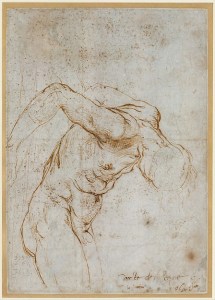Contributed by Kate Liebman / The Metropolitan Museum�s Department of Drawings and Prints is celebrating its centennial this year, and has devoted a wall to �one masterpiece��per week through April 30, 2017. This week�s masterpiece was a portrait of a church man drawn by Jean Fouquet in the mid-15th century. I stopped by to check it out.


The gallery rotates its exhibitions frequently because the prints and drawings are extremely sensitive to light and cannot be displayed for more than a few weeks at a time. Included in this rotation (through October 24) are: a selection of Goya�s etchings; a wall of drawings and prints that depict two figures (women weeping, men boxing); prints that celebrate the theme of America, as seen by European and American artists; and a number of linocut and woodblock prints from the portfolio Prints of the Mexican Revolution.
While I was there, I visited the Department�s Study Room to take a look at a few prints and drawings in their collection, which includes more than one million items, all of which are stored in archival solander boxes in temperature controlled rooms on site. Not everything is catalogued in the electronic database with its corresponding image, but every item does have its own card in the retro card-cataloging system. Many of the acquisitions come in large gifts, and all are approved by the curators and the paper conservators.

The Department often collects multiple impressions of a single print. I took a look at three impressions of Albrecht Durer�s engraving Adam and Eve, including one facsimile (far right in the image below), in which the subtleties of the dark tones drop out. Because of the differences among inks and papers, the impressions all look a bit different. Note the goat balancing on the steep cliffs in the upper right corner, and the complexity of the negative spaces. It was worth the visit just to see this print, unframed and without the glare of a glass covering.

I also took a look at two etchings that seemed related: Fragonard�s The Tax Collectors (1778) and Lucian Freud�s Ill in Paris (1948). (For copyright issues, the Freud piece cannot be reproduced here, but here�s a link to the Met�s site.) Both artists etched thin lines into hard ground to get the value contrast. Both feature an ill figure on a bed. And both contain an overriding sense of anxiety: Freud�s because of its close crop, its thorny flower, and Kitty�s blank eyes; Fragonard�s because of the shadow cast behind the dying man and the scene depicted — a man on his deathbed facing the greedy and feared tax collectors, hand already on a pouch of gold.

Lithographs by Siqueiros and Orozco were up next, and I was quite impressed — and surprised — by the scale and honesty of the Siqueiros Self-Portrait (1937-8). I loved the moment in Orozco�s On the Road: women carrying children and guns (1929) of the woman gently holding her baby�s foot. Again, for copyright reasons, the images can only be viewed on the Met’s website (link to Siqueiros here and Orozco here)
Another group had pulled some amazing drawings from the Renaissance: Leonardo, Raphael, and Michelangelo. The Leonardo was exactly as you might expect: the proportions perfect, the touch delicate, the eyes glistening with emotion.

The Raphael was a double sided drawing: on one side was Mary and babies Jesus and Joseph, on the other a study of a nude male figure in motion.


Finally, as I was leaving, one of the staff members made sure I saw the Michelangelo. It was another twofer. Both sides were studies for the Libyan Sibyl, one of the female seers painted on the Sistine Chapel, though he had a man in his studio to model for him. It�s an astounding drawing, partly because it contains, on the same page, anatomical precision, two different sizes of the sitter�s head, and multiple tries — look at the three iterations of the toes — all in a vivid red chalk.�


Visiting the Study Room at the Met�s Department of Drawings and Prints is super easy, and, best of all, free, but remember to call ahead. Link here.
Related posts:
Interview: Melissa Brown�s currency
PRINTMAKING: Sylvan Lionni at Kansas
Printmaking Monday: I�m a steamroller baby
















